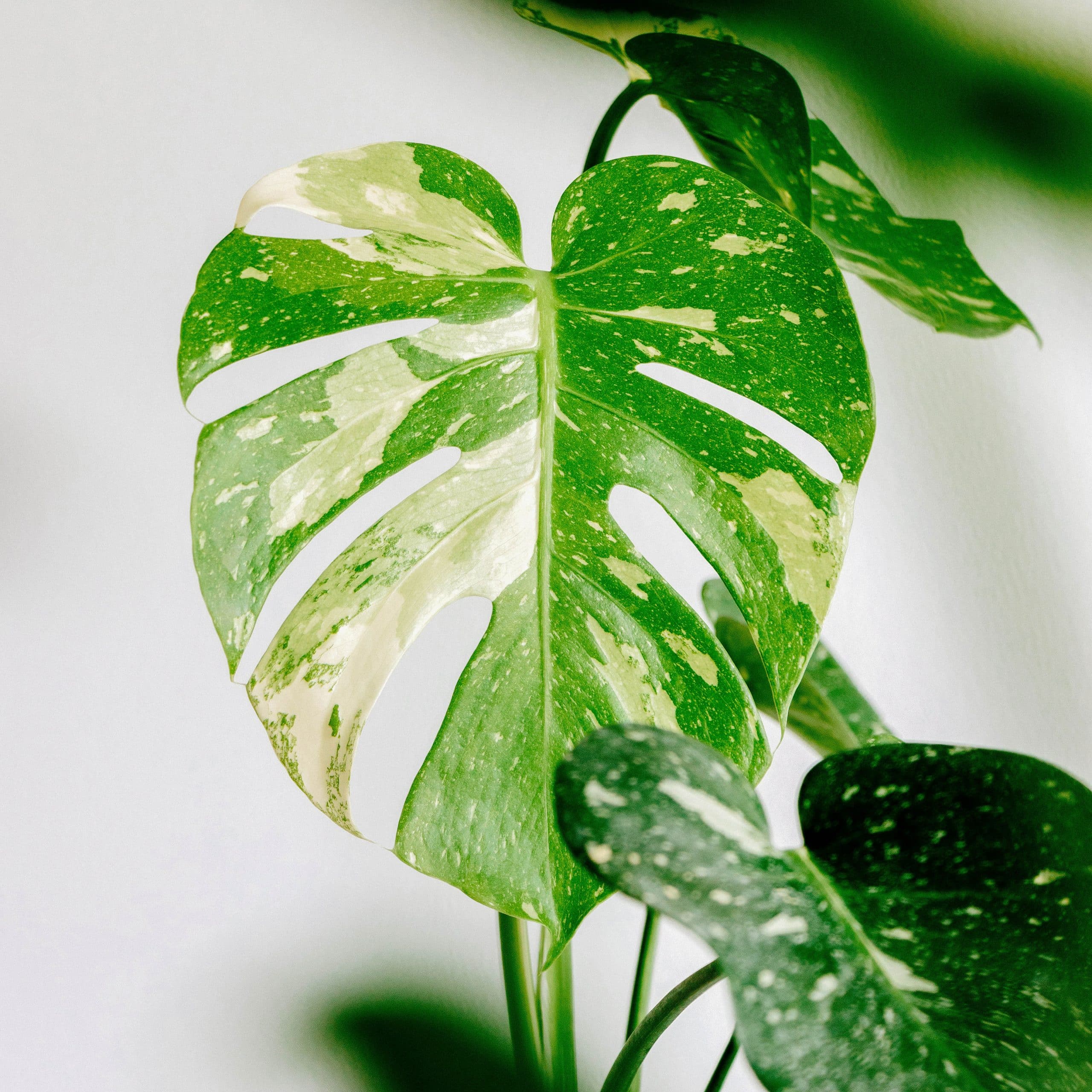Fallen in love with the fabulous Monstera ‘Thai Constellation’? You’re not alone. These beautiful variegated houseplants are the ultimate eye-catchers, but they do need some special care to keep them alive and thriving.
Keep reading to find out everything you need to know in order to successfully grow a Thai Constellation Monstera in your home!
| Common name(s) | Thai Constellation Monstera, variegated Monstera |
| Scientific name | Monstera deliciosa ‘Thai Constellation’ |
| Family | Araceae |
| Height and spread | Up to 8 feet long and 4 feet wide |
| Light | Bright indirect |
| Soil type | Aroid soil |
| Water | Keep lightly moist |
Disclosure: If you shop from my article or make a purchase through one of my links, I may receive commissions on some of the products I recommend.
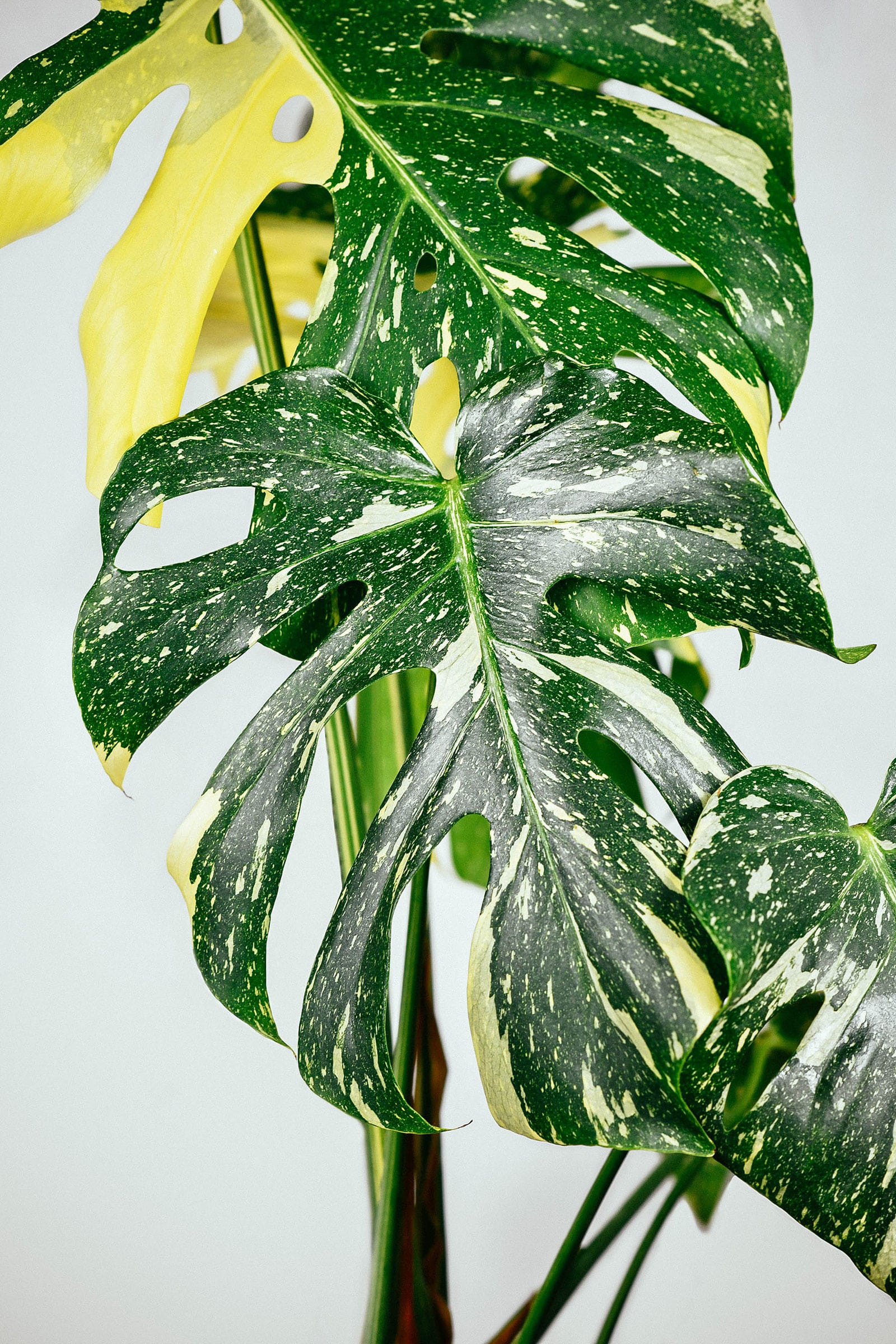
What is Monstera ‘Thai Constellation’?
As its name suggests, Monstera ‘Thai Constellation’ is a member of the Monstera family. This genus is highly popular in the houseplant hobby thanks to eye-catching species like M. adansonii (the Swiss cheese plant) and M. siltepecana (the silver Monstera).
The most popular Monstera of them all is Monstera deliciosa (also incorrectly called the split-leaf Philodendron, even though it’s not a Philodendron at all). And this one just happens to be the parent plant for Monstera ‘Thai Constellation’ as well!
In order to understand what the Thai Constellation Monstera is and where exactly it came from, we’ll have to have a look at a few basic horticultural principles. It’s a bit of a complicated story.
Origins
First off, one thing you need to know about plants is that it isn’t unusual for them to emerge from their seeds with certain mutations, or even spontaneously mutate as they grow. Some of these mutations are incompatible with life, but others aren’t.
In fact, some are considered highly desirable.
One of the most desirable mutations is variegation. Thanks to a lack of chlorophyll (the stuff that makes leaves green) in certain parts of their foliage, variegated houseplants have a beautiful marbled cream and green appearance. They often fetch higher prices than the regular version of the same plant. (Looking at you, Pink Princess Philodendron.)
Third, mutations like variegation aren’t always stable. Sometimes a plant just grows out of them eventually. If one pops up that looks decorative and is stable, though, a nursery might smell profits. They can patent the plant in question, give it a catchy name and start mass-producing it through propagation.
These variations of a plant are referred to as cultivars, and their names are usually written as Genusname ‘Cultivarname’. In this case: Monstera ‘Thai Constellation’ or Monstera deliciosa ‘Thai Constellation’.
Although its origins are a little murky (I can’t find the patent for it), the Thai Constellation Monstera is known to have been produced in a laboratory in Thailand.
I’m not sure if that means it was genetically manipulated or the lab just isolated a spontaneous mutation, but in any case, they managed to produce a plant with a spectacular and stable variegated leaf pattern.
Appearance
Unsurprisingly, though undoubtedly with the help of some good marketing, Monstera ‘Thai Constellation’ took the world by storm. Although it’s not the only variegated Monstera deliciosa cultivar, it’s sought-after for its fine speckled pattern of green and cream, rather than larger patches of color. Almost like a starry constellation!
Other than its spectacular leaf coloration, ‘Thai Constellation’ is still a typical split-leaf Monstera. This species is characterized by its large foliage with extensive fenestration, which is basically a fancy word for holes and splits.
Naturally a climbing species that uses taller trees for support, this Central American native can grow absolutely huge, soaring to heights of 65 feet or more in the wild.
It won’t reach sizes like that in the home, especially the variegated cultivars—they’re a little slower-growing—but you can still count on a Thai Constellation Monstera to eventually grow leaves that are 15 inches or more across.
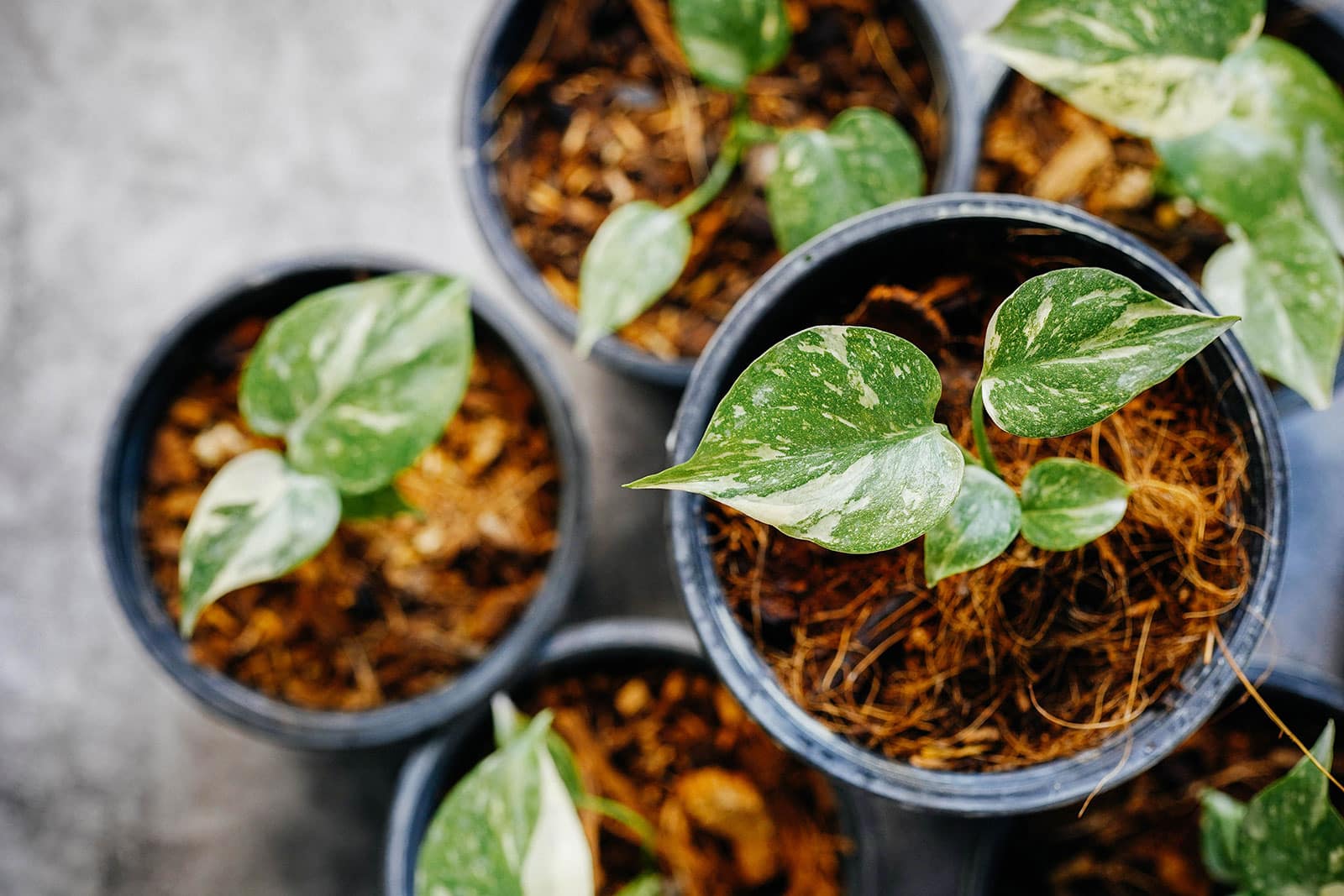
Why is Monstera ‘Thai Constellation’ so expensive?
It might boggle the minds of folks who aren’t into collecting houseplants that someone would pay hundreds or even thousands of dollars for a plant, but here we are!
New, spectacular cultivars are introduced regularly, which often results in everyone wanting to hop on the bandwagon and prices initially soaring.
Monstera ‘Thai Constellation’ is no exception. This cultivar’s price has dropped and stabilized a good bit at the time of writing, but when it was first offered for sale, houseplant enthusiasts were willing to pay serious money for it. Still, even now, it’s not a cheap plant.
But why is the Thai Constellation Monstera so expensive?
Well, there are several reasons, but the main one is that, for a long time, the Thai lab that produced it was the only large-scale supplier.
After all, variegated plants can’t be grown from seed. They have to be reproduced asexually—that is, through propagation. Apparently ‘Thai Constellation’ hasn’t proven the easiest to produce.
For example, although the US-based Costa Farms announced its introduction to the American market with much ado back in 2020, they later released a statement saying they were having trouble mass-producing the plant due to “some quirks that are preventing us from producing the tens of thousands of baby plants we need from tissue culture.”
In the end, it’s all a matter of supply and demand. Slow-growing and somewhat challenging to produce in large numbers, Monstera ‘Thai Constellation’ is still highly coveted, which is what has allowed prices to stay high.
Let’s just hope someone figures out how to nail the tissue culture problem so we can all stop paying $75 for a baby plant with three leaves!
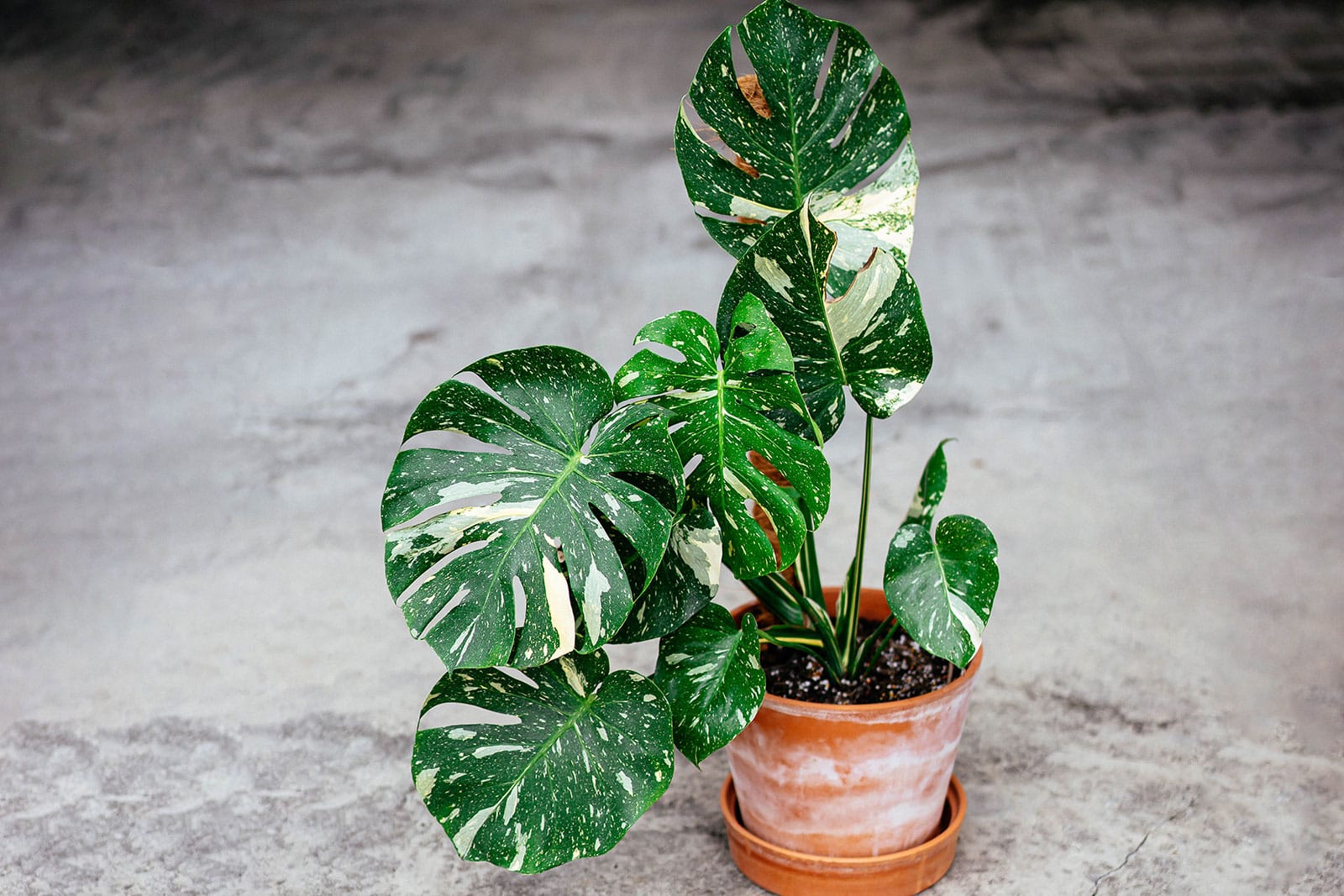
Where to buy Monstera ‘Thai Constellation’
As mentioned, Monstera ‘Thai Constellation’ isn’t quite as rare and expensive now as it was when it was first introduced. Still, you may not be able to find it at your local garden center or plant store. If you want one, searching online is the easiest option.
Some places you can try if you want to buy a ‘Thai Constellation’ include:
Most large online houseplant stores now also carry this cultivar. You could even try checking Facebook groups meant for houseplant swapping and sales, although it’s important to keep an eye out for possible scams.
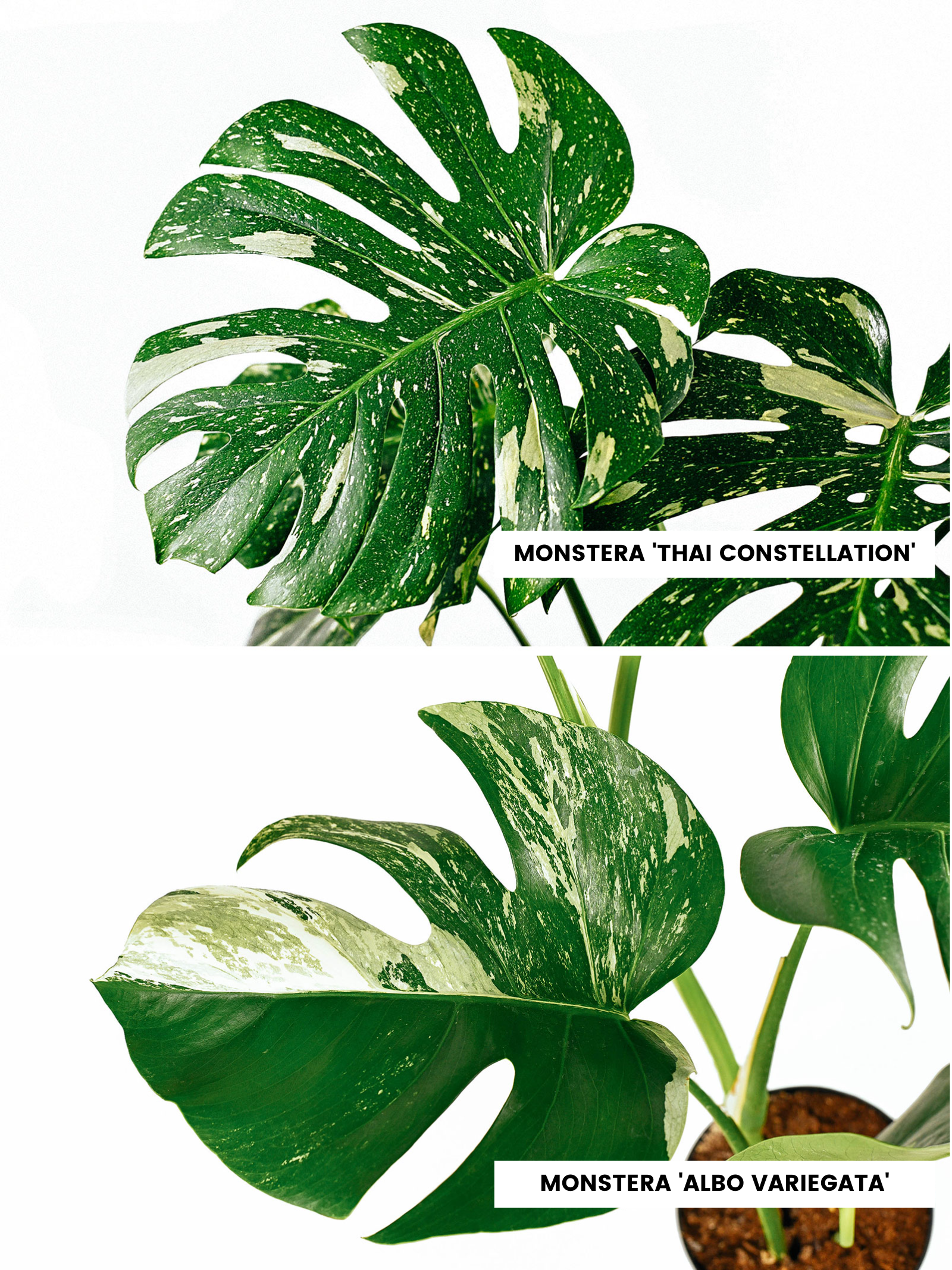
Monstera ‘Albo’ vs ‘Thai Constellation’
As I mentioned, Monstera ‘Thai Constellation’ isn’t the only variegated cultivar of Monstera deliciosa. There are a bunch, but most common one is called Monstera ‘Albo’ (sometimes Monstera ‘Albo Variegata’).
If you’re specifically looking to buy a ‘Thai Constellation’, it’s a good idea to make sure you’re able to tell the difference between the two.
After all, the variegation on ‘Albo’ is known to be less stable, and it can sometimes end up reverting back to regular green foliage. This doesn’t happen with the Thai Constellation Monstera.
Both cultivars are quite similar in looks, featuring patches of green dusted with lighter variegation, as well as larger colorless leaf sections. There are some differences, though:
- The variegation on M. ‘Albo’ is cream or even almost white. On M. ‘Thai Constellation’, it leans more toward yellowish.
- The variegation on ‘Albo’ tends to be less consistent than on ‘Thai Constellation’. Each leaf is usually significantly different from the next.
- On ‘Thai Constellation’, all green patches are at least lightly speckled. On ‘Albo’, this is not necessarily the case.
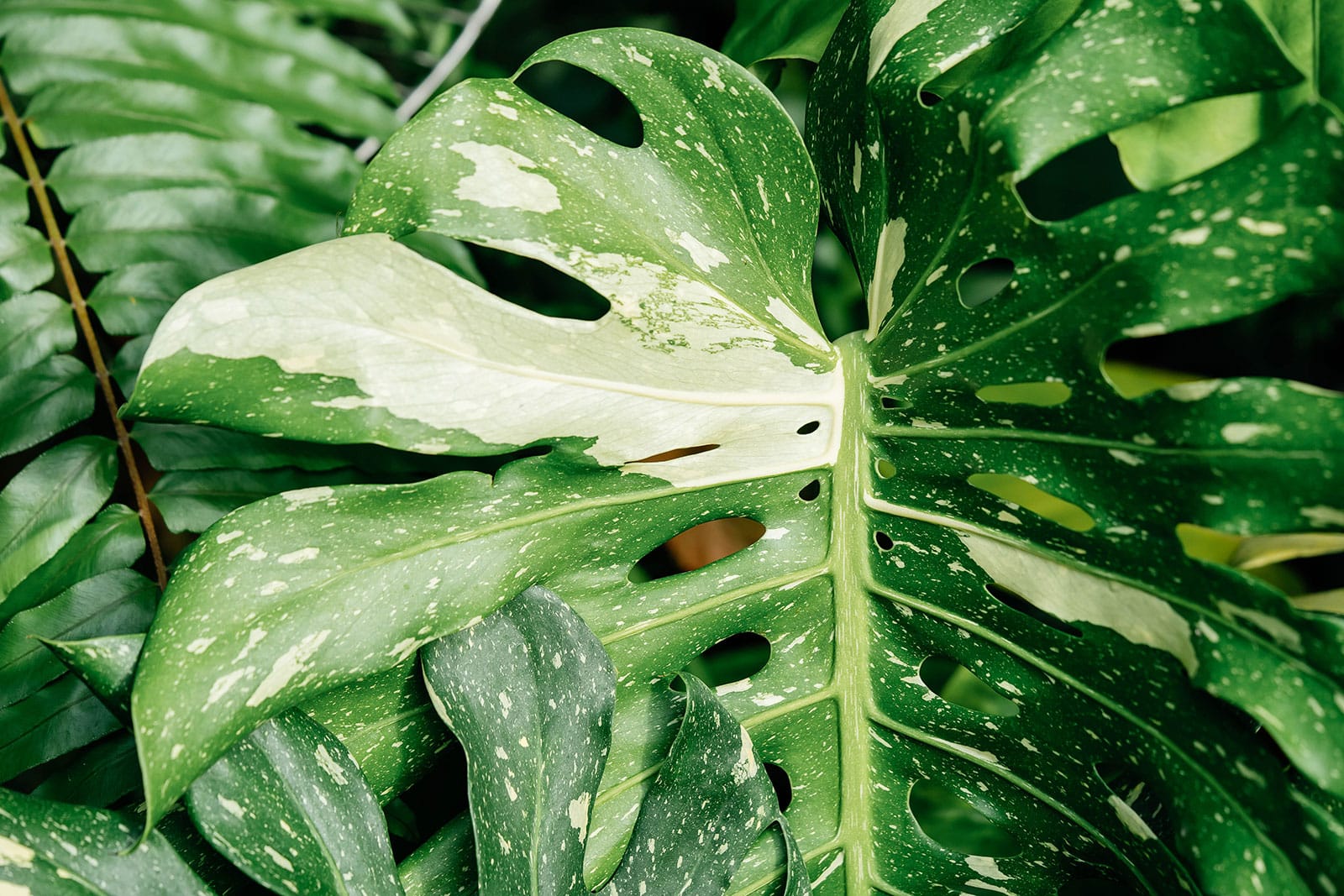
5 tips for keeping your Monstera ‘Thai Constellation’ alive and healthy
So, you’ve acquired a Monstera ‘Thai Constellation’? Congrats!
Now, let’s find out how to keep your new variegated pride and joy alive and help it grow to its full potential.
Variegated plants in general, including Monsteras, are known to be more challenging to grow than their green counterparts. They’re also slower growers.
It’s not that surprising if you think about it: They lack chlorophyll, which is the green pigment that allows plants to photosynthesize. Less photosynthesis means fewer nutrients, slower growth, and a less forgiving plant.
The good news is that houseplant lovers report that ‘Thai Constellation’ appears at least a bit sturdier than some of its other variegated cousins. So no need to panic.
Let’s have a look at what you can do to help yours grow gigantic, using five basic tips.
1. Don’t underestimate the power of light.
I can’t emphasize this enough. Most people fail to understand how much light houseplants, particularly more fragile variegated cultivars, actually need.
Sure, you shouldn’t overdo it, as their lack of chlorophyll makes them susceptible to burning in direct sunlight. But your Monstera ‘Thai Constellation’ definitely can’t be more than a few feet away from the window either!
Find your plant a spot that receives plenty of bright but indirect light for the best results, or go for artificial lighting if you don’t have any suitable window spaces.
2. Remember its tropical origins.
As I briefly mentioned, Monstera deliciosa (the parent plant for ‘Thai Constellation’) is naturally found in Central America. Specifically, it occurs from Mexico down to Panama, where it inhabits tropical rainforests.
This species has evolved to be perfectly adapted to the rainforest life, and it will struggle in different environments. So, you’d do well to remember its tropical origins if you want it to thrive in your home.
That means:
- Never expose your Thai Constellation Monstera to cold. Room temperature or up is ideal for this plant. It will stop growing under 59°F and any frost will instantly kill it.
- As discussed above, no harsh direct sun, please. Taller trees would block out the most intense rays in the rainforest, so Monstera isn’t used to being blasted by sunlight.
- Humidity is important! Like many other tropical houseplants, ‘Thai Constellation’ suffers in dry air. If your home’s air moisture levels regularly drop below 50 percent, you may have to run a humidifier.
3. Treat it like the semi-epiphyte it is.
Semi-what? An epiphyte is a plant that doesn’t grow in soil, but clings to other plants for support instead. It’s not a parasitic thing the way mistletoe is; in fact, many epiphytes have mutually beneficial relationships with their host. Air plants from the genus Tillandsia are a good example.
Monstera deliciosa isn’t a full epiphyte like air plants, as it does root in the soil. However, as it matures, it depends less and less on its connection to the ground. Instead, it produces air roots, which help it to cling to its host tree and are also able to absorb some nutrients and water.
What this means for your potted Monstera ‘Thai Constellation’ is that it won’t like being planted in a dense mixture, nor does it appreciate waterlogged soil. Its roots prefer a loose, well-draining soil mixture, just enough to keep it from falling over but with excellent airflow.
This is a trait that it shares with a number of common houseplants, especially other members of the family Araceae (such as mini Monstera, satin Pothos, Black Velvet Alocasia, and Zebra Alocasia).
As a result, you can buy “aroid soil” in some specialty plant shops. These mixtures have less or no standard potting soil and are mostly made up of chunky materials like perlite, fine bark chips, and occasionally charcoal. To make sure they still retain some water, sphagnum moss is often included as well.
Pre-mixed aroid soil can be pretty pricey, but the good news is that you can also make it yourself. Everyone has their favorite “recipe,” and what works best for you depends on your watering habits, but a basic mixture might consist of:
- 1 part high-quality houseplant potting soil
- 1 part perlite
- 1 part fine orchid bark
- 1 part sphagnum moss fibers
I’ve also grown Monsteras in a simple mix of potting soil and perlite, but since these variegated cultivars are a little more fickle, I personally wouldn’t try this with ‘Thai Constellation’.
Recommended products for making Aroid soil:
- FoxFarm Ocean Forest Potting Soil
- Perfect Plants Organic Perlite
- Better-Gro Orchid Bark
- Better-Gro Orchid Moss
4. Let it climb.
You probably saw this one coming, given its semi-epiphytic nature and habit of clinging to taller trees in the wild: Monstera ‘Thai Constellation’ loves to climb.
Whereas you could get away with growing a regular Monstera without support for a while, I’d recommend attaching your variegated plant to a moss pole or plant totem ASAP for the best results. They grow much better when you do so, producing larger and healthier foliage.
All you have to do is find a sturdy pole, preferably a textured one so the plant has something to cling onto. Using some string, gently attach your Monstera’s stem to the support. The plant will take care of the rest, eventually producing air roots that attach themselves to the pole, and following it upward.
Tip: Keep in mind that a mature Monstera is quite heavy and might cause its support to fall over. As yours grows, be sure to provide it with something tall and sturdy in a wide heavy pot. I don’t know about you, but I personally dream of a gloriously huge ‘Thai Constellation’ attached to a full-sized driftwood trunk!
5. Repot regularly.
Although they’re not the quickest growers, a ‘Thai Constellation’ is still a Monstera. If you’ve got all of the other care requirements on this list down, yours should produce new leaves throughout the summer growing season. It will likely outgrow its planter on a yearly basis!
To make sure your plant has all the space it needs, and to keep its soil from decomposing over time, it’s a good idea to repot regularly. As soon as you feel the soil is beginning to dry out very quickly, or if there are roots sticking out of the drainage holes in the bottom of the planter, it’s time to go one pot size up.
Tip: Houseplants are best repotted at the start of the growing season, which is in spring.
How to keep a Monstera ‘Thai Constellation’ variegated
As discussed, the majority of variegated Monsteras can revert to green. This isn’t the case with Monstera ‘Thai Constellation’, but you do need to keep in mind that yours may produce more or fewer showy leaves based on the conditions you grow it in.
The most important factor is light. We’ve already found out that these plants need plenty of bright indirect light to grow, but did you know that brightness (or lack of it) also affects variegation?
If a Thai Constellation Monstera feels like it’s not getting enough, it will try to produce leaves with more green coloration and fewer of those pretty cream-colored splashes. After all, more green means more chlorophyll, meaning it can photosynthesize more effectively.
Light-starved houseplants will also begin to stretch, with leaves growing further and further apart, and new leaves can become smaller and smaller. Not the best look.
So I can’t stress this enough: Light is your (and your plant’s) best friend!
Propagating Monstera ‘Thai Constellation’
Can’t get enough of ‘Thai Constellation’? Yeah, me neither. Luckily, you can multiply an existing specimen for free by means of asexual reproduction (propagation), although it has to be said that cuttings of this cultivar tend to be a little slow to root.
If you want to propagate your Monstera ‘Thai Constellation’, or if you’ve opted to buy an unrooted cutting to save money, here’s how you turn it into an established new plant:
Stem cuttings
A stem cutting is taken by beheading a plant. You cut the top part of the stem, including a few leaves, and then optionally take more cuttings with some stem and foliage on each of them. You should also include a stem node on your cuttings (which looks like a little brown bump), as this is where roots and new leaves grow from.
The stem cutting is then placed in fresh aroid soil or, more popularly, planted in water. The whole thing can be set in a location that’s bright but not sunny, warm and with high humidity levels for the best results.
After a few weeks, you should be able to see the first roots appear on your Monstera stem cutting. Once these roots are a few inches long, the plant can be potted in normal soil and it should keep growing as usual. Voilà, a brand new ‘Thai Constellation’! It’s almost like magic.
Did you know? More fragile plants like Monstera ‘Thai Constellation’ are also often rooted in LECA, sphagnum moss, or perlite. These more specialized propagation methods are a bit more of a hassle, but they tend to have higher success rates.
Wet sticks
Expensive houseplants are often sold as “wet sticks”, which is a method of taking cuttings that allows one to chop them into dozens of pieces and produce a whole bunch of new plants, rather than just going for a single stem cutting.
The catch is that wet sticks don’t have leaves: they’re literally just small pieces of stem with one or multiple nodes. This means that although they can absolutely be used to grow a brand new Monstera ‘Thai Constellation’, the process takes significantly longer. Some houseplant enthusiasts struggle to get wet sticks to root and begin producing leaves.
The trick is that the water rooting method isn’t ideal for wet sticks. Instead, your best bet is to get a cheap little propagation tray, like the ones used for germinating seeds. Fill it with damp sphagnum moss, maybe add some perlite, lay the sticks on top and place the lid on the propagation to keep moisture in.
Set the whole thing in a spot that’s bright but not sunny. If temperatures are on the low side, you can even consider using a heat mat under the tray to make sure things are nice and toasty like these plants prefer. Keep the moss moist, but never wet, by spraying it regularly.
It can take a while, so be patient, but eventually you should see the node(s) on the wet sticks begin to swell with growth. Once they’ve produced a few good roots and a leaf or two, they can be moved to a regular pot with aroid soil, and you can begin to care for them like a normal Monstera.
Did you know? I’ve mentioned tissue culture a few times. This propagation method involves reproducing plants using as little as a few cells in a completely sterile environment. It’s used by nurseries to mass-produce houseplants, but unfortunately, it’s something we hobbyists don’t have access to at home.
Common questions about Monstera ‘Thai Constellation’
Is Monstera ‘Thai Constellation’ toxic to cats and dogs?
The genus Monstera belongs to the family Araceae, the Aroids. These plants are known for their calcium oxalate content (microscopically small, sharp crystals) in their sap.
Although ‘Thai Constellation’ won’t poison your pet, it can cause irritation to the mouth and throat if the leaves or stems are eaten, so it’s best kept out of their reach.
Can you grow Monstera ‘Thai Constellation’ from seed?
No, unfortunately you can’t. If you sow ‘Thai Constellation’ seeds, you’ll just get regular green Monsteras, as the genetic mutation doesn’t carry over. So don’t fall for sketchy online ads advertising variegated Monstera seeds—they’re a scam!


